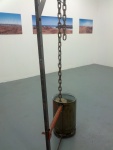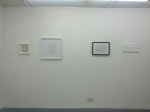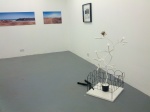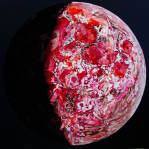Echolalia
Echolalia exhibition, TACTIC Cork, August 2012
Selected works from selected artists from the year-long “Chinese Whispers” project [2010]
Ian-John Coughlin
Darragh Hughes
Bryan Keane
Kay Bear Koss
David Madigan
Suzanne Mooney
ECHOLALIA: |ˌekōˈlālēə|
meaningless repetition of another person’s spoken words [as a symptom of psychiatric disorder].
This exhibition has been curated from work by six of twelve artists that participated in a twelve-month long experimental collaboration, the success of which was, by design, largely dependent upon the dedication, and participation of the entirety of the group. Or so we thought. Although the original objective might never have been actualized, the process itself was a highly valuable catalyst for exposure to different media, different work processes, idea generation and further relationships and collaborative events- this exhibition of selected works, for example.
The pieces have been chosen that best illustrate the “threads” of consciousness that were followed; of the transmission, interpretation and reiteration of an idea; the shift of focus, and attention, and emphasis; the transmutation of a concept as it is translated not only across media, but across mindset and viewpoints. The priority of the original intention of a piece is often overshadowed by the next artist’s fascination with a particular shape, colour, material or emotional reaction… again, and again, and again, like words shouted back and forth across the valley of communication and comprehension that lies between us all… though never and not at all meaningless.
I would like to thank my fellow artists participating in this show for their dedication and commitment to this project, to their practices, and to creating meaning. Be Prolific.
The Exquisite Corpse Will Drink The Young Wine
Ian John Coughlin
The ‘Chinese Whispers’ project was dreamed up on a bitter cold December night in 2009 over a bottle of Jameson’s Whiskey. It was the solution to a number of problems a few of us thought needed addressing. With the finding of the studio and gallery space, a disparate collection of creative individuals had been brought together under one roof. Comprising visual and sound artists, fashion designers and musicians, to name but a few, the new enterprise had been launched with a group exhibition. A more invasive activity was necessary, something that would provoke investigation and analysis and would also yield creative results…
In contemporary art, collaborations of employment are everywhere. Artists, often unskilled in so many areas, frequently call upon experts in other fields to increase the quality of their work. Be it directing a performer or employing a
craftsperson, we reach out and beg indulgences, that if they just stick with us and keep an open mind, it will all work out. Yet, true collaborations are rare. By ’true’, I mean the shared genesis, cultivation and execution of an idea. Individuality does have a bearing when it comes to assessing common goals and preoccupations. Some collaborative forces are legendary. Christo and Jean-Claude, for example, though there was always a clear bias, even in that partnership. Perhaps it is the nature of the condition; the idealistic notion of an artist in solitude, seeking the one truth. This romantic fantasy falls flat in the face of a profitable practice and engagement with society.
Concerned with such ideas as the mystique of accident and collective consciousness, the Surrealists formulated a technique involving a collective collage of words or images called the “cadavre exquis” (exquisite corpse). Based on an old parlor game, it was played by several people, each of whom would write a phrase on a sheet of paper, fold the paper to conceal part of it, and pass it on to the next player for his contribution. The technique got its name from results obtained in initial playing, “Le cadavre / exquis / boira / le vin / nouveau” (The exquisite corpse will drink the young wine). Other examples are: “The dormitory of friable little girls puts the odious box right” and “The Senegal oyster will eat the tricolor bread.” These poetic fragments were felt to reveal what Nicolas Calas characterized as the “unconscious reality in the personality of the group” resulting from a process of what Max Ernst called “mental contagion.” The game was quickly adapted to the possibilities of drawing, and even collage, by assigning a section of a body to each player, though the Surrealist principle of metaphoric displacement led to images that only vaguely resembled the human form.
The western schoolyard has spawned a number of children’s games not dependent on the use of props. One such game is known as ‘Chinese Whispers.’ All racial implications aside, the game was based upon the passing of a message from one player to the next, and so on, each participant reiterating and interpreting until one player, crumbling under the weight of the accumulated gibberish, would mispronounce, misinterpret and lose the game. The game is quite popular in the western world, going by a number of different names. In Germany, Stille Post (Silent Post), in France téléphone arabe (Arab phone) and so forth. With the game’s name deemed politically incorrect in the west, it is now known as Telephone or Whisper down the Lane. In slang terms, however, the title has also passed into common usage. When a rumour is circulated, be it through a locale or national media, and the facts become altered with each telling, the voices are said to be engaged in ‘chinese whispers.’ It is often invoked as a metaphor for cumulative error, especially the inaccuracies as rumours or gossip spread, or, more generally, for the unreliability of human recollection.
It was these facts that helped influence and formulate a device by which twelve artists could collaborate equally in a project lasting over the course of a year. Taking January 2010 as a starting point, each of the twelve participants would create a piece of art and, with the end of the month as deadline, pass it down their ‘thread’ to the next artist. Simultaneously, they would receive a piece from another artist to which they would respond by making another piece of work. At the end of that month, their response would, again, be passed along to another artist. With a rotating timetable, each participant would, at one point or another, exchange a piece of work with all eleven others, the final works being a culmination of twelve threads of influence and inspiration from their peers. This would generate 144 works from which a final exhibition would be curated, in addition to facilitating each artist’s creation of new ideas, practices and a new body of work.











